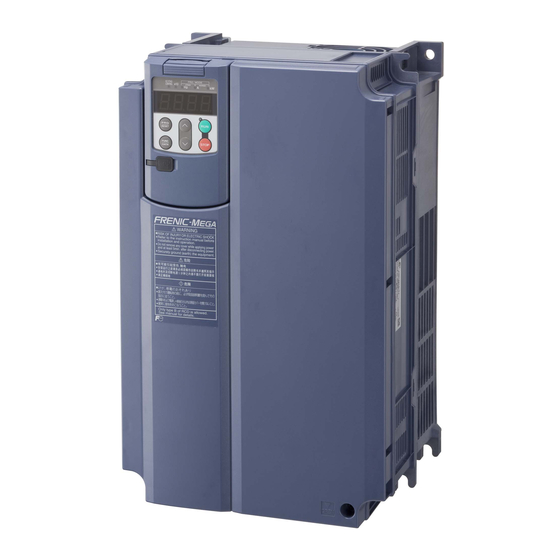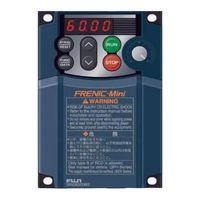
Fuji Electric Frenic Mega Series Manuals
Manuals and User Guides for Fuji Electric Frenic Mega Series. We have 5 Fuji Electric Frenic Mega Series manuals available for free PDF download: User Manual, Connection Manual
Fuji Electric Frenic Mega Series User Manual (774 pages)
High Performance, Multifunction Inverter
Brand: Fuji Electric
|
Category: Inverter
|
Size: 31 MB
Table of Contents
-
-
Features22
-
Operation46
-
-
Installation54
-
Wiring56
-
-
-
Alarm Mode146
-
USB Connectivity148
-
-
-
Test Run152
-
-
-
-
-
Droop Control230
-
-
Maintenance240
-
-
-
Lu Undervoltage320
-
S Overspeed332
-
-
-
Control Block479
-
-
-
-
-
Specifications499
-
Connection500
-
-
Multi-Monitor501
-
Test-Running503
-
Real-Time Trace504
-
Historical Trace505
-
-
-
-
-
Option560
-
-
-
Meter Options646
-
Frequency Meters646
-
-
-
-
-
General679
-
-
General688
-
Compliance688
-
-
Appendices
695
Advertisement
Fuji Electric Frenic Mega Series User Manual (680 pages)
High Performance, Multifunction Inverter
Brand: Fuji Electric
|
Category: Inverter
|
Size: 22 MB
Table of Contents
-
-
-
-
-
-
Arresters150
-
Surge Absorbers151
-
-
Standard Models153
-
Keypad161
-
-
Meter Options229
-
Frequency Meters229
-
-
-
-
Function Codes231
-
-
-
Droop Control280
-
-
Maintenance290
-
-
-
-
Control Block504
-
-
Running Mode521
-
Programming Mode535
-
Alarm Mode574
-
-
-
Specifications587
-
Connection588
-
-
-
Appendices
631-
-
A.2 Noise634
-
Noise Prevention636
-
Index669
-
Fuji Electric Frenic Mega Series User Manual (634 pages)
High Performance, Multifunction Inverter
Brand: Fuji Electric
|
Category: Inverter
|
Size: 12 MB
Table of Contents
-
-
Features16
-
-
-
Keypad76
-
-
-
-
-
Meter Options214
-
-
-
Maintenance268
-
-
-
Control Block435
-
-
Running Mode451
-
Programming Mode462
-
Alarm Mode491
-
USB Connectivity493
-
-
-
Specifications503
-
Connection504
-
-
Multi-Monitor505
-
Test-Running507
-
Real-Time Trace508
-
Historical Trace509
-
-
-
Troubleshooting512
-
-
Appendices
540-
-
A.2 Noise543
-
Noise Prevention545
-
-
Advertisement
Fuji Electric Frenic Mega Series User Manual (172 pages)
RS-485
Brand: Fuji Electric
|
Category: Inverter
|
Size: 1 MB
Table of Contents
-
-
Features12
-
-
-
Connections23
-
-
Messages42
-
-
-
-
Messages68
-
-
-
Point Database150
-
Strategies152
-
Monitoring152
-
-
-
Digital Outputs153
-
Loop Gains154
Fuji Electric Frenic Mega Series Connection Manual (112 pages)
INVERTER SIO
Driver
Brand: Fuji Electric
|
Category: Inverter
|
Size: 2 MB




